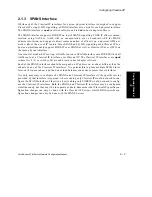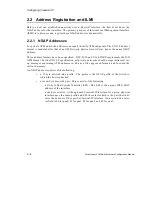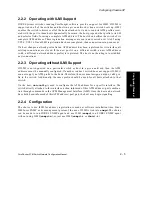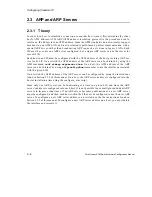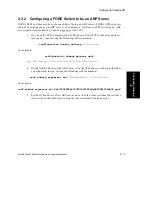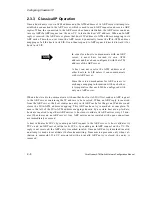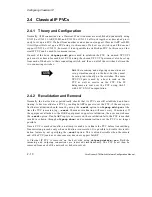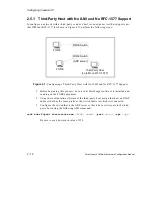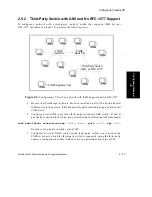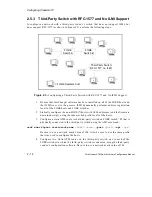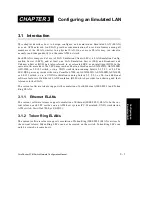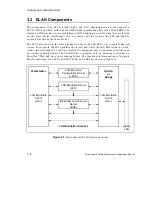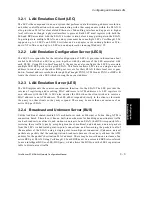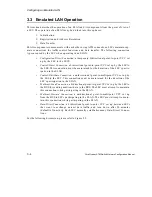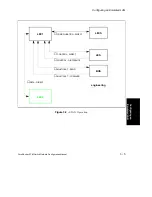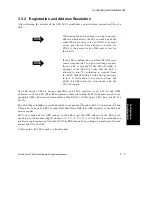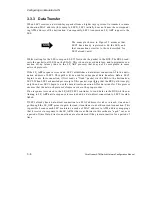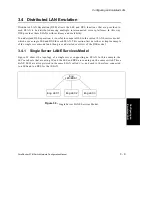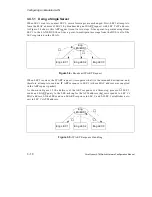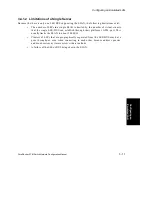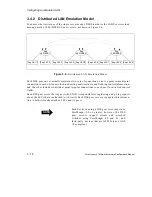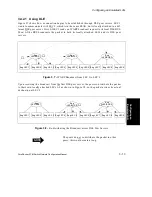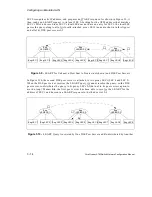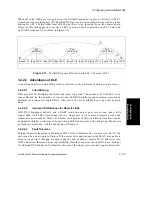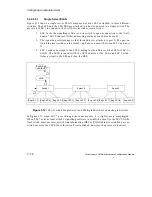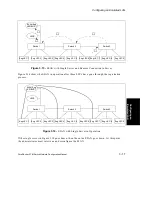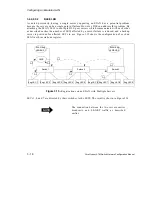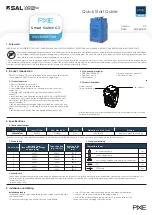
ForeRunner
ATM Switch Network Configuration Manual
3 - 3
Con
figurin
g an
Em
ul
ated
LAN
Configuring an Emulated LAN
3.2.1 LAN Emulation Client (LEC)
The LEC is the component in an end system that performs data forwarding, address resolution,
and other control functions when communicating with other components within the ELAN. It
also provides a MAC level emulated Ethernet or Token Ring interface and appears to higher
level software as though a physical interface is present. Each LEC must register with both the
LES and BUS associated with the ELAN it wishes to join before it may participate in the ELAN.
To participate in multiple ELANs, an end system must have multiple LECs. ForeThought 5.2.x
supports up to 16 LECs on ES-3810 switches and on adapter cards running Solaris or Win-
dows/NT software, and up to 4 LECs on on adapter cards running Windows/95.
3.2.2 LAN Emulation Configuration Server (LECS)
The LECS is responsible for the initial configuration of LECs. It provides information about
available ELANs that a LEC may join, together with the address of the LES associated with
each ELAN. Using DLE in ForeThought 5.2, the user may also configure the LECS to associate
multiple LES/BUS pairs with a given ELAN. This feature allows LECs to use a single, anycast
address to reach one of the other DLE peer servers for their ELAN if their local server goes
down. Normal address resolution through ForeThought PNNI, ATM Forum PNNI, or IISP will
locate the closest, active LES which is using the anycast address.
3.2.3 LAN Emulation Server (LES)
The LES implements the control coordination function for the ELAN. The LES provides the
service of registering and resolving MAC addresses to ATM addresses. A LEC registers its
own address with the LES. A LEC also queries the LES when the client wishes to resolve a
MAC address to an ATM address. The LES either responds directly to the client or forwards
the query to other clients so they may respond. There may be more than one instance of an
active LES per ELAN.
3.2.4 Broadcast and Unknown Server (BUS)
Unlike traditional shared-media LAN architectures such as Ethernet or Token Ring, ATM is
connection based. Therefore, it has no built-in mechanism for handling connectionless traffic
such as broadcasts, multicasts, and unknown unicasts. In an ELAN, the BUS is responsible for
servicing these traffic types by accepting broadcast, multicast, and unknown unicast packets
from the LECs via dedicated point-to-point connections, and forwarding the packets to all of
the members of the ELAN using a single point-to-multipoint connection. (Unknown unicast
packets are packets that the sending station broadcasts because it does not yet know the ATM
address for the packet’s destination MAC address. There may be more than one instance of an
active BUS per ELAN. Using ForeThought 5.2 each BUS must be a colocated BUS (also referred
to as an intelligent BUS or a LES/BUS pair), which allows the BUS to use the LES’s registration
table to direct unicast traffic.
Summary of Contents for forerunner series
Page 6: ......
Page 16: ...TOC 10 ForeRunner ATM Switch Network Configuration Manual Table of Contents ...
Page 20: ...LOF 4 ForeRunner ATM Switch Network Configuration Manual List of Figures ...
Page 22: ...LOT 2 ForeRunner ATM Switch Network Configuration Manual List of Tables ...
Page 30: ...viii ForeRunner ATM Switch Network Configuration Manual Preface ...
Page 144: ...3 58 ForeRunner ATM Switch Network Configuration Manual Configuring an Emulated LAN ...
Page 180: ...6 12 ForeRunner ATM Switch Network Configuration Manual ATM Forum PNNI ...
Page 220: ...9 6 ForeRunner ATM Switch Network Configuration Manual Configuring Timing ...
Page 300: ...D 24 ForeRunner ATM Switch Network Configuration Manual Configuring FramePlus Modules ...
Page 308: ...Acronyms 8 ForeRunner ATM Switch Network Configuration Manual Acronyms ...
Page 346: ...Glossary 38 ForeRunner ATM Switch Network Configuration Manual Glossary ...
Page 352: ...Index 6 ForeRunner ATM Switch Network Configuration Manual Index ...

